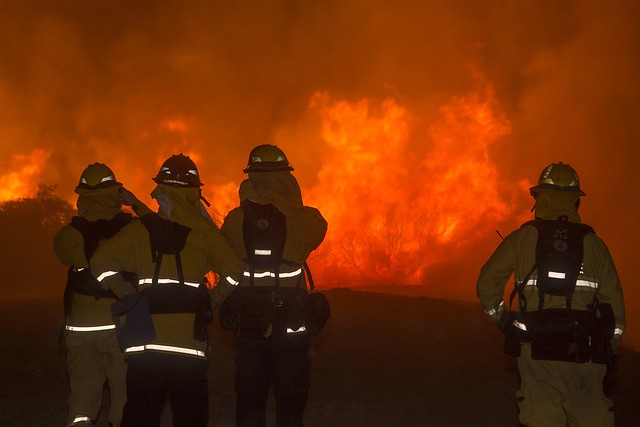
Secretary of Agriculture Sonny Perdue, Secretary of the Interior Ryan Zinke, and Forest Service Interim Chief Vicki Christiansen briefed members of Congress yesterday on what to expect in the coming fire season. (To view photos from yesterday’s briefing, please view the 2018 Fire Briefing and MOU Signing Flickr album)
The USDA Forest Service is well prepared to respond to wildfires in what is currently forecast to be another challenging year. In 2018, the agency has more than 10,000 firefighters, 900 engines, and hundreds of aircraft available to manage wildfires in cooperation with federal, tribal, state, local, and volunteer partners.

Large parts of the western U.S. are predicted to have above-average potential for significant wildfire activity this year, according to the latest forecast released by the National Interagency Fire Center (NIFC). The “National Significant Wildland Fire Potential Outlook,” released May 1st, predicts above-average significant wildland fire potential in about a dozen Western states at various times between now and the end of August, including Arizona, California, Colorado, Idaho, Kansas, Montana, Nevada, New Mexico, Oregon, Texas, Utah, and Washington.
Wildland fire potential depends on weather and fuel conditions, which can and often do change, so NIFC issues an updated Outlook on the first day of each month. The number of wildfires and acres burned annually depends not only on wildland fire potential, but also on the number and timing of lightning strikes and human-caused ignitions.
“By mid-summer, we expect warmer and drier-than-average conditions, large amounts of grass, melting of below-average snowpack, and increasing potential for thunderstorm activity and lightning starts to create above-average potential for significant wildfire activity in a large part of the western U.S.,” said Ed Delgado, National Program Manager, Predictive Services, NIFC.
An interview with Delgado on the May 1 Outlook is available at www.nifc.gov.

At this time, the Forest Service believes the number of firefighters, engines, aircraft, and other wildfire suppression assets to be appropriate to meet its needs within available funding. However, if the wildfire season turns out to be as severe as the current NIFC Outlook indicates, the agency’s wildfire suppression costs could exceed available funding, requiring the Forest Service to transfer funds from non-fire programs to make up the difference.
In 2017, the Forest Service’s wildfire suppression costs reached a historic high of $2.4 billion. Through the 2018 Omnibus Bill, Congress provided the Forest Service with a total of $1.5 billion for wildfire suppression this year and changed the way that wildfire suppression is funded beginning in Fiscal Year 2020. In the long run, this will allow us to continue our non-fire mission operations uninterrupted, including on-the-ground forest health improvements that prevent catastrophic wildfires from threatening lives, homes, and communities.
Nationally, nearly nine out of ten wildfires are human-caused. Members of the public can help the Forest Service and other wildland fire agencies by learning how to prevent human-caused wildfires. The fewer human-caused wildfires that agencies like the Forest Service have to respond to, the more they can focus on the lightning-caused wildfires that can’t be prevented. Campfires are the single biggest source of human-caused wildfires on land the Forest Service manages.
For more information about campfire safety and how to prevent other types of human-caused wildfires, visit smokeybear.com.




